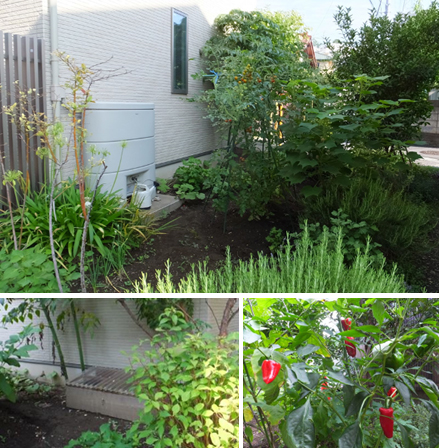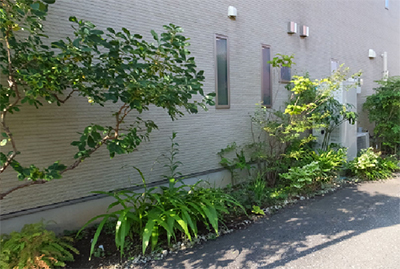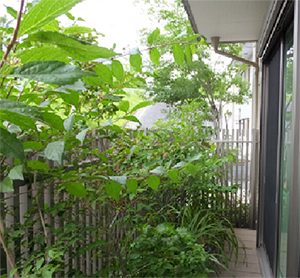Institute of Environmentology, Research and Education for Sustainability or Sustainable Development, Kazutoshi Fujihira
Inagi Ecogarden
Institute of Environmentology >> Inagi Ecogarden
Inagi Eco-garden is the exterior area that surrounds the Inagi Ecohouse. This exterior area is by no means large; however, there are a variety of considerations for sustainability everywhere.
The first characteristic of the Inagi Ecogarden is the adoption of “open exterior” style, which can give clear and unobstructed views. There are no fences and gates, except the one surrounding the veranda, which is necessary for privacy.
The second feature is that there is no space for parking on the site. Inagi Ecohouse is not far from railway stations, so there is no need to own a private car. More accurately, this place has been selected since it has easy access to walk to the railway stations. As a result, the housing site has a larger green area, instead of a parking lot.
Vegetable garden area: circulation of food and water
On the east side of the lot, the area adjacent to the house is used as a “vegetable garden.” In usual years, several kinds of vegetables, such as eggplants, sweet peppers, edamame (green soybeans) and cherry tomatoes, are cultivated. At this vegetable garden, food and water are intended for circulation.
Fertilizer for growing the vegetables is the compost that is made from the kitchen garbage in a composter. The composter, which is placed next to the vegetable garden, is a type named “Bacteria de Kiero.” Bacteria de Kiero has been devised by a resident in Hayama Town, Kanagawa Prefecture, and is widely used in some municipalities, including Hayama Town, Zushi City and Kamakura City. This composter has a structure which allows sunlight and wind to pass through. The kitchen garbage buried in the underground is discomposed into compost by microbial action. Since this composter started to be used, troubles such as offensive smells have never occurred. Cultivation by using the compost also seems to be effective for bountiful growth of the plants.
When watering the vegetable garden, the occupants use rainwater stored in the rainwater tank. The water in the tank brings a sense of security because it can be used as emergency water. Meanwhile, almost all rainwater which falls on the house’s roof and other places in this lot, finally permeate into the ground. This water movement has been intended to resemble natural water circulation.

Various plants and natural-style gardening
Around the vegetable garden area, various kinds of trees and herbs have been planted. We have strived to make a natural-style garden, bearing in mind the native vegetation. Most of the plants are native species, which grow naturally in this region. There are also fruit trees, such as a yuzu (Citrus junos) and kumquat, so various wild birds visit here.
The green plant zone stretches from the east side of the house to the north side, along the northern frontal road. There is also a green strip outside the entrance porch and slope on the west side. There are no obstacles such as fences, so the plants are easily viewed from the road side. Accordingly, conversations with neighboring residents and passersby sometimes begin, with the plants as a starting point.

Sustainable southern space created by plants and fences
The tall tree that has been planted in the green space between the slope and veranda is a Japanese ash, Fraxinus lanuginose. This Japanese ash, a deciduous tree, seasonally adjusts the sunlight entering the staircase through the stairs’ windows. The luxuriant foliage in the summer blocks strong sunlight; the tree with no leaves in the winter allows the sunlight to go into and warm the indoor atmosphere.
We have strived to make the veranda area comfortable, safe and environment-friendly. The 180cm-high and vertical-latticed fence effectively screens the home and the washing hung in the veranda from the public view. Meanwhile, any suspicious person hiding behind the fence can be seen through the openings of the vertical lattice. The wind also passes through the fence’s openings, so the home has good ventilation in summer.

The structure of this veranda is also favorable for face-to-face communication between the occupants and the neighbors. The veranda deck level is at about 50cm above the ground, so the height from the veranda deck to the fence’s top is 130cm. Therefore, a person standing on the veranda deck can easily communicate with neighboring residents.
There is also a green strip under the fence in which ground covers have been set. Moreover, several small trees are planted on the veranda side of the fence. Transpiration from the plants helps to alleviate the heat of summer, which leads to the mitigation of urban heat island.
Related publications
Sustainable Home Design by Applying Control Science
Written by Fujihira, K., InTech, December 2017
Chapter 5
Case Study: Detached House Designed by Following the Control System
